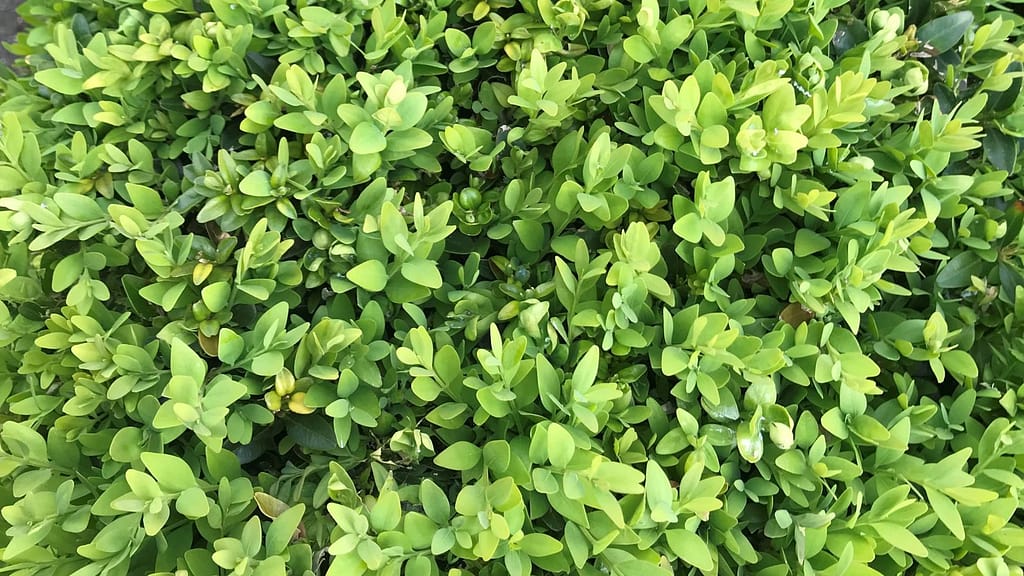Box blight, a fungal disease, was already cutting a swathe through the traditional English box garden in many parts of the country when the Box moth caterpillar arrived to join the party. First recorded in the UK as long ago as 2007 it was not until 2011 that it was reported to be affecting Box in private gardens.

Originally affecting London and the South East it is now spreading around the country with reports of infestations in 2019 from Scotland and North Wales.
The first signs of the caterpillar are slight die-back and loss of leaves, often with white webbing coating areas of leaves. These hungry caterpillars can rapidly devour an entire hedge or topiary ball. There are no natural predators in this country so action is needed if you want to save your box plants. However all is not lost, even if the plants are completely defoliated they may recover with careful feeding and treatment.
With the caterpillar now widespread in many areas, especially London and the South East, for the gardener looking for a low maintenance solution switching to alternative plants may make more sense.
What you can do to try to control it
Monitor and remove!

Monitor box and remove any caterpillars. Physically removing and destroying the caterpillars is the simplest method of control. However, this is a time consuming process and requires commitment! You will need to check your box regularly in Spring and Summer when the caterpillars are active. Removing them when they first appear is important because numbers will rapidly multiply.
Your efforts may also be affected by the actions of your neighbours if they also have box plants as infestations spread easily.
XenTari spray
There is a biological control spray available to control the caterpillars. XenTari is a biological insecticide which doesn’t harm other wildlife. Three treatments throughout the growing season should control the caterpillars. Anecdotal reports suggest this is effective and can even enable box plants to recover after they have been completely defoliated by the caterpillars.
Pheromone traps
Pheromone traps can be used to trap the moths, therefore preventing them from laying eggs in your plants. This is especially effective when combined with spraying as the trap will alert you to when the moths are laying eggs and therefore when you will need to spray.
Focus on plant health
Keep box plants well fed. Healthy box is more likely to survive both blight and box moth caterpillars so giving it a regular feed is key to maintaining its health.
If all these options fail there are many plants that can be used as an alternative to box hedging and topiary. I have listed a few of the most similar replacements but for further inspiration visit RHS Wisley to view the wide range of box alternatives being trialled in the Walled garden East.
Alternative plants for hedging and topiary

Euonymous microphyllus
Euonymous microphyllus – A dense evergreen shrub which grows well in sun and part shade, it is also happy in containers and copes well in exposed coastal positions. It is slow growing so a good option for low maintenance hedges.
Ilex crenata

Ilex crenata – (Japanese holly) has similar small leaves to box and is an excellent alternative for topiary and small hedges as it is slow growing.
Hebe rakaiensis

Hebe rakaiensis – Naturally forms small compact mounds of bright green foliage making a useful alternative to box balls. Produces white flowers in summer and should be given a light trim after flowering if you want to keep it small. Grows to a maximum size of about 1m.
Lonicera nitida ‘Elegans’
Lonicera nitida ‘Elegans’ – Fast growing so will need multiple pruning throughout the year. However it is not prone to diseases and grows well in most soils making it suitable for tricky positions and larger hedges.
Pittosporum tenuifolium ‘Golf Ball’
Pittosporum tenuifolium ‘Golf Ball’ – Named because of its neat, compact growth habit which makes it another useful alternative for ball topiary, but needs a sunny position.
Yew – Taxus baccata

Yew – Taxus baccata – Traditionally used for larger hedges and topiary in historic British gardens but Taxus is reasonably slow growing and can be clipped to form small hedges too. Suitable for all well drained soils and grows particularly well on sandy soils. It will sulk and die if it suffers waterlogged roots so choose another alternative if your soil is often damp.

For garden design services including more advice on alternatives to box for your garden please get in touch

